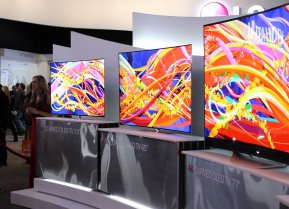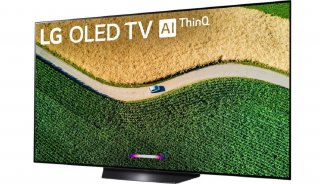QLED vs. OLED: Which is Best for Up-Close TV Viewing?
Fact: With OLED TVs, even though they are markedly more expensive than their QLED counterparts, you can count on an excellent viewing experience even from the most extreme angles.
Long ago, if you sat too close to an old-school TV, you would likely be quite distracted by the screen’s scan lines. Well, fortunately, we no longer have to worry about such eyesores.
However, if you do sit too close to your HDTV, you still may see slight rows and columns of pixels, which could in fact hamper your overall viewing experience. If you just can’t move your seat back, it may be in your best interest to purchase a new HDTV that can better meet your needs.
If you’re in the market for a high-end model, you will likely end up looking at QLED or OLED panels. Because of their reliance on powerful LED backlighting, QLED sets are known for their remarkable brightness. Most of Samsung’s QLED TVs can produce anywhere between 1,000 and 2,000 nits of brightness, hence the brilliant whites. If you’re sitting that close to your TV, however, that may be more of a net negative for your sensitive eyes.
Moreover, compared to their archrival OLED TV offerings, QLEDs have been shown to fail miserably when it comes to wide-angle viewing. So, if you have wraparound or side seating with extreme TV angles, the panel can lose contrast and look discolored or tainted if you happen to be stuck on the outside seating areas. If you are directly in front of the screen, though, such issues aren’t as apparent.
The most logical choice would be to go with a panel that is highly regarded for its incredible quality—no matter the angle you’re viewing it. What most past tests and reviews have shown are that OLED panels will always come out on top because of their accurate colors, deepest blacks and inimitable uniformity and contrast ratios. And that’s exactly what your eyeballs will get to enjoy even if you’re sitting a bit closer to the TV than you should be.
With OLED TVs, even though they are markedly more expensive than their QLED counterparts, you can count on an excellent viewing experience even from the most extreme angles. Since these panels boast self-emissive pixels that provide perfectly uniform screens, there is no need for space-hogging backlighting that often impart clunkier designs to non-OLED models.
To its credit, Samsung is constantly on the lookout to improve the overall viewing on its QLED TV offerings. There certainly have been improvements in the more recent models, but for Samsung to reach the much-vaunted levels of OLEDs, that would likely mean that the company would have to hit a home run with its forthcoming QD-OLED hybrids.
Ethen Kim Lieser is a Science and Tech Editor who has held posts at Google, The Korea Herald, Lincoln Journal Star, AsianWeek and Arirang TV. He currently resides in Minneapolis.


